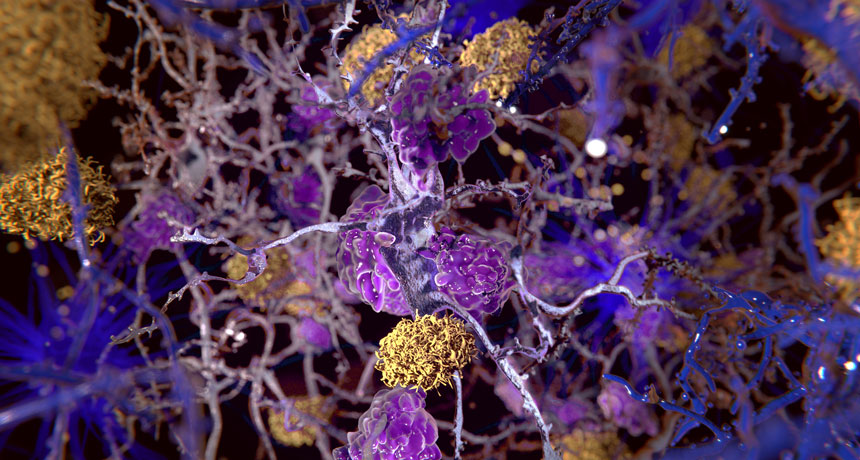Specks in the brain attract Alzheimer’s plaque-forming protein
Globs of an inflammation protein beckon an Alzheimer’s protein and cause it to accumulate in the brain, a study in mice finds. The results, described in the Dec. 21/28 Nature, add new details to the relationship between brain inflammation and Alzheimer’s disease.
Researchers suspect that this inflammatory cycle is an early step in the disease, which raises the prospect of being able to prevent the buildup of amyloid-beta, the sticky protein found in brains of people with Alzheimer’s disease.
“It is a provocative paper,” says immunologist Marco Colonna of Washington University School of Medicine in St. Louis. Finding an inflammatory protein that can prompt A-beta to clump around it is “a big deal,” he says.
Researchers led by Michael Heneka of the University of Bonn in Germany started by studying specks made of a protein called ASC that’s produced as part of the inflammatory response. (A-beta itself is known to kick-start this inflammatory process.) Despite being called specks, these are large globs of protein that are created by and then ejected from brain immune cells called microglia when inflammation sets in. A-beta then accumulates around these ejected ASC specks in the space between cells, Haneke and colleagues now propose.
A-beta can directly latch on to ASC specks, experiments in lab dishes revealed. The two proteins were also caught in close contact in brain tissue taken from people with Alzheimer’s disease. Researchers didn’t see any ASC specks mingling with A-beta in the brains of people without the disease.
Mice engineered to produce lots of A-beta had telltale signs of its accumulation in their brains at 8 and 12 months of age, roughly comparable to middle age in people. But in mice that also lacked the ability to produce ASC specks, this A-beta brain load was much lighter, and these mice performed better on a memory test. Similar reductions in A-beta loads came when researchers used an antibody to prevent A-beta from sticking to ASC specks, results that suggest the specks are needed for A-beta to clump up.
The details show “a quite new and specific mechanism” that’s worth exploring for potential treatments, says Richard Ransohoff, a neuroinflammation biologist at Third Rock Ventures, a venture capital firm in Boston.
To be effective as a treatment, an antibody like the one in the study that kept A-beta from sticking to ASC would need to be able to enter the brain and persist at high levels — a big challenge, Ransohoff says. Still, the results are promising, he says. “I like the data. I like the line of experimentation.”
Many questions remain. The results are mainly from mice, and it’s not clear whether ASC specks and A-beta have similar interactions in human brains. Nor is it obvious how to stop the A-beta from accumulating around the specks without affecting the immune system more generally.
What’s more, the role of the microglia immune cells that release ASC specks is complex, Colonna says. In some cases, microglia serve as brain protectors by surrounding and sequestering sticky A-beta plaques in the brain (SN: 11/30/13, p. 22). But the current results suggest that by releasing ASC specks, the same cells can also make A-beta accumulation worse. The dueling roles of the cells — protective in some cases and potentially harmful in others — make it challenging to figure out how to tweak their behavior therapeutically, Colonna says. 